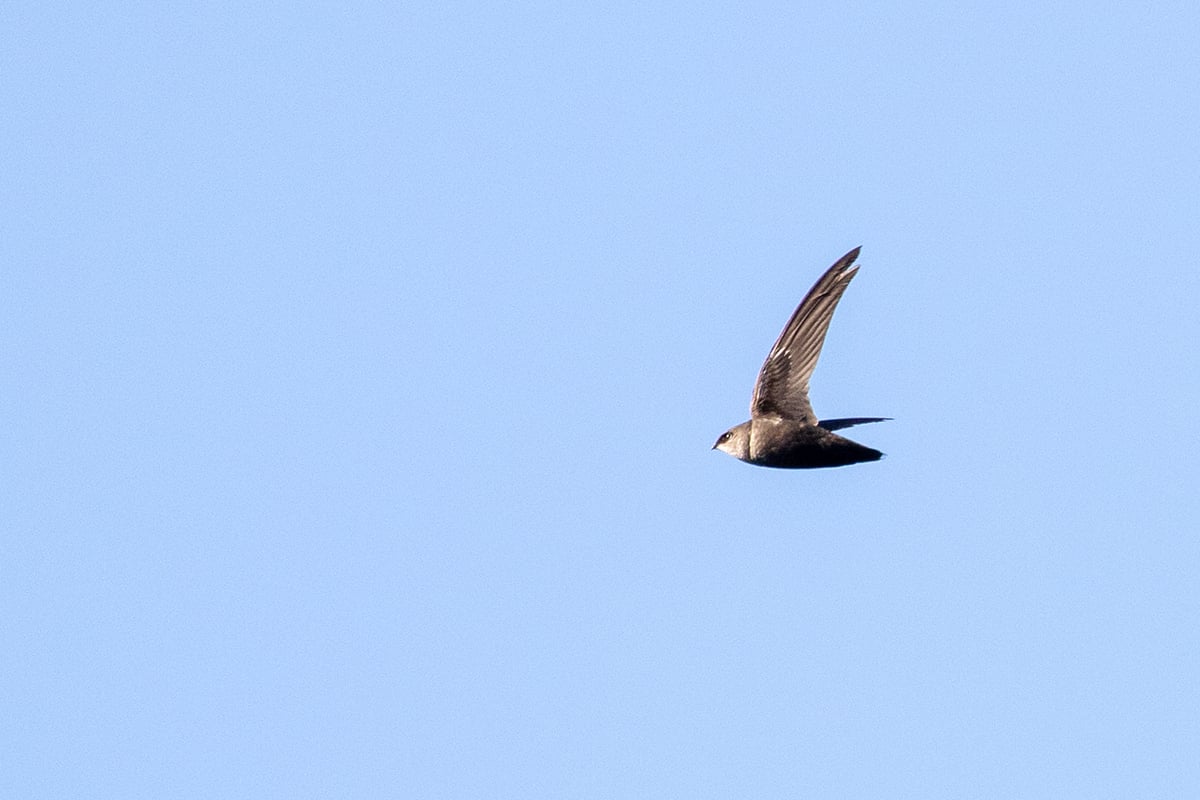Chimney Swifts
The Chimney Swift (Chaetura pelagica) is one of the most aerial of birds. They eat entirely in flight, dining on numerous species of flies, beetles, termites, flying ants, bees, wasps, and moths. In addition, these birds drink, collect nesting material, and possibly even copulate "on the wing."
What makes them even more unique is that they are the only breeding bird in Massachusetts that builds its nest and successfully raises its young in chimneys.
How to Identify Chimney Swifts
Said to look like "a flying cigar," the sooty gray Chimney Swift has a short body (4.5–5.5 inches) and wings that are narrow, slightly curved, and have a spread of 12–13 inches.
Their unassuming brown color, fluttery flight, and high-pitched voices have caused them to occasionally be confused with bats, but Chimney Swifts are birds through and through. They fly with rapid, erratic wingbeats that are interspersed with short, quick glides. As they fly through the air, swifts make a loud chattering or twittering call.
Chimney Swift Behavior
Chimney Swift Life Cycle
Chimney Swifts are a breeding bird species in Massachusetts. Their spring arrival in New England from their wintering South American grounds coincides with the emergence of flying insects. In late April or early May, both male and female swifts start to build their nests in dark, sheltered locations like chimneys, old wells, air shafts, and sometimes barns or attics.
The half-saucer shaped nest is made of twigs and attached to the inside wall of the chimney with the bird's glutinous saliva. The nest can be placed anywhere from 2-22 feet down from the top of the chimney. Four or five eggs are laid every other day during June or July until the clutch is completed. Incubation is by both parents and lasts 18-21 days.
After being cared for in the nest for just over two weeks, the young become adventurous and begin to cling to the wall near the nest and take short flights. Some 14-18 days later the fledglings leave the nest, returning to the chimney only to rest or roost at night. During this time they feed on their own.
Chimney Swift Song
What to Do If Chimney Swifts Nest in Your Chimney
Chimney Swifts are the only Massachusetts bird that builds its nest and successfully raises its young in chimneys. While they may roost in large numbers in big chimneys or airshafts, only single pairs nest in house chimneys.
If a homeowner determines that there is a nest in the chimney—usually by the loud chattering of the young as the parents enter with food—there is no reason for concern. The presence of a nest will not cause a fire or spread disease.
The only time it is necessary to intervene is if an active nest has fallen onto the damper or into the fireplace. In this case, every attempt should be made to return the young to the chimney so the parents can continue to care for them.
If a nest has fallen, you can nail a small basket (a plastic berry basket is fine) near the top of a piece of wood that is at least 5 inches wide and 3-4 feet long. Place the young—and any remnants of the nest—into the basket. Then, carefully raise the board into the chimney, rest it on the damper, and lean it against the inside chimney wall. The nest should be as high as possible in the chimney, allowing the parents to fly down the chimney and feed the young from behind.
Wait a few hours for the parents to locate the nest, then listen for the loud chattering of the young as a parent enters the chimney with food. When the adult leaves, the nest is silent until the parent once again returns with food.
If the adults are feeding the young in the replacement nest, no further steps are required. Many licensed wildlife rehabilitators will not take baby Chimney Swifts. Their diet of regurgitated insects makes it extremely difficult for the young to survive in the care of humans. Learn more about bird nest situations & solutions
Threats Facing Chimney Swifts
Today, Chimney Swifts are widespread, but may be suffering the same insidious decline seen in other aerial insectivores – a decline yet to be linked to a definitive cause. Learn more about their historic distribution in Mass Audubon’s Breeding Bird Atlas.
How Mass Audubon is Supporting Birds in Massachusetts
Mass Audubon works at our wildlife sanctuaries and beyond to ensure that the nature of Massachusetts continues to thrive. By scientifically monitoring Massachusetts birdlife, Mass Audubon informs important conservation decisions and launches targeted initiatives to help at-risk species. In addition, fostering healthy habitats, supporting native species, and educating people about the importance of nature conservation is critical to our success. Learn more about our work
How You Can Support Birds in Massachusetts
Mass Audubon supports birds like the Chimney Swift every day, but we couldn’t do it without the support of our 160,000+ members.
Help support Chimney Swifts, and birds like them, by becoming a member today.
Upcoming Bird Programs
Spring Lecture Series: The Unique Courtship of the American Woodcock
-
Greylock Glen, Adams
-
Friday, March 14
6:00-7:30pm
Adults
Spring Birding at Fowl Meadows
-
Burma Trail Parking Lot, Milton
-
Saturday, March 15
8:00-11:00am
Adults
Birding 101
-
Moose Hill Wildlife Sanctuary, Sharon
-
Saturday, March 15
9:00-10:30am
Adults
Stay Connected
Don't miss a beat on all the ways you can get outdoors, celebrate nature, and get involved.



